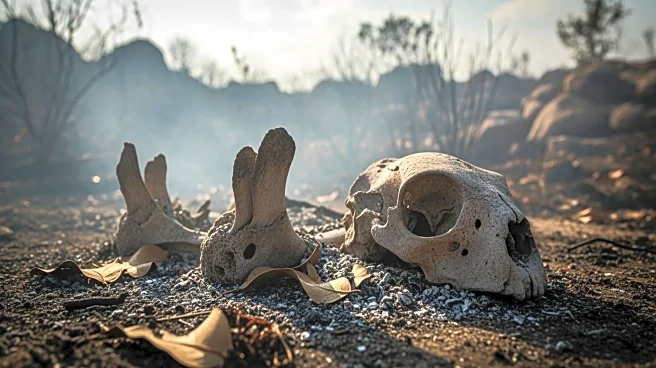What's Happening?
Archaeologists in Norway have uncovered a 1,500-year-old reindeer hunting facility as glaciers continue to melt due to global warming. The discovery was made on the mountain plateau of Aurlandsfjellet,
where a hiker led researchers to the site. The facility includes wooden mass-capture fences, marked antlers, weapons, and a uniquely decorated oar. The site, believed to have been used during the 6th century, offers insights into historical hunting practices. The melting ice has preserved these artifacts, allowing archaeologists to study them in detail. The University Museum of Bergen and Vestland County Municipality are involved in the excavation and conservation efforts.
Why It's Important?
This discovery is significant as it provides a rare glimpse into ancient hunting practices and the impact of climate change on archaeological sites. The melting glaciers are revealing artifacts that would otherwise remain hidden, contributing to the field of ice archaeology. The findings offer valuable information about the cultural and historical context of the region, enhancing our understanding of past human activities. The preservation of these artifacts due to ice coverage highlights the importance of climate change research and its implications for historical studies.
What's Next?
The University Museum of Bergen, supported by the Norwegian Agency for Cultural Heritage, is working to conserve the artifacts. Researchers aim to date and analyze the objects to gain further insights into their historical significance. Some of the artifacts may eventually be displayed to the public, providing educational opportunities and raising awareness about the effects of climate change on cultural heritage. Continued melting of glaciers may lead to more discoveries, prompting further archaeological investigations in the region.
Beyond the Headlines
The discovery raises ethical and cultural questions about the preservation of artifacts in the face of climate change. As glaciers continue to melt, more historical sites may be exposed, necessitating discussions on conservation priorities and resource allocation. The unique nature of the wooden mass-capture facility also challenges existing archaeological theories about hunting practices in ancient Europe, potentially leading to new interpretations and scholarly debates.











